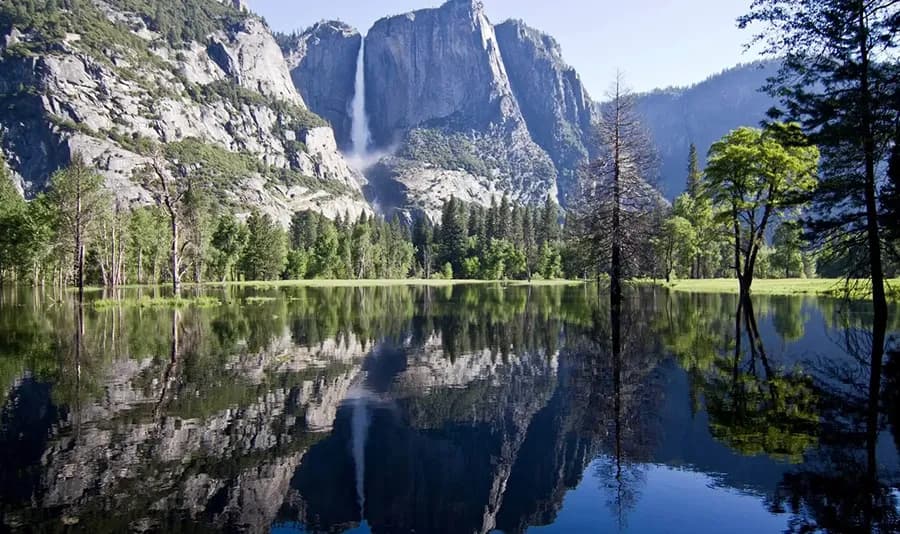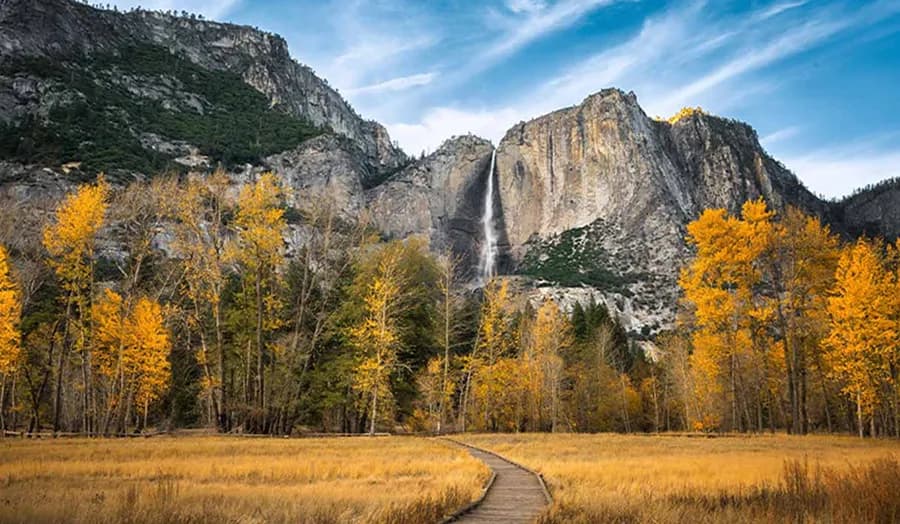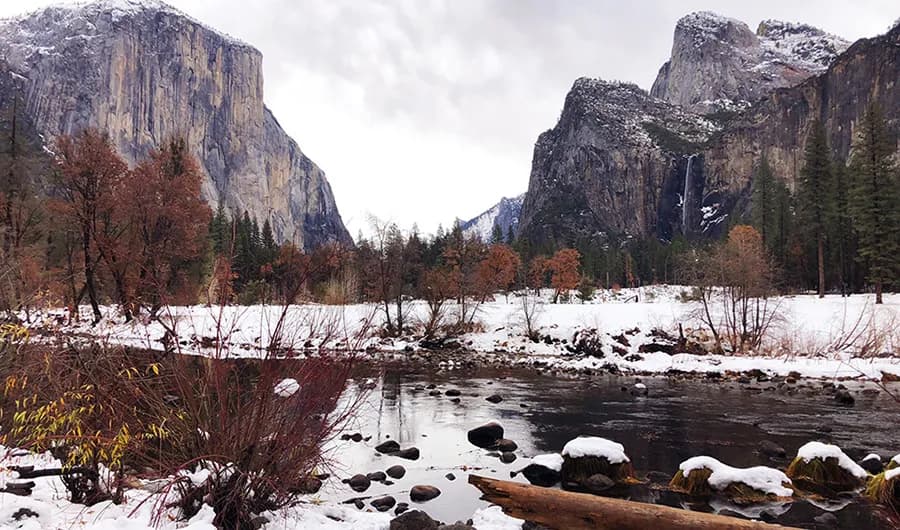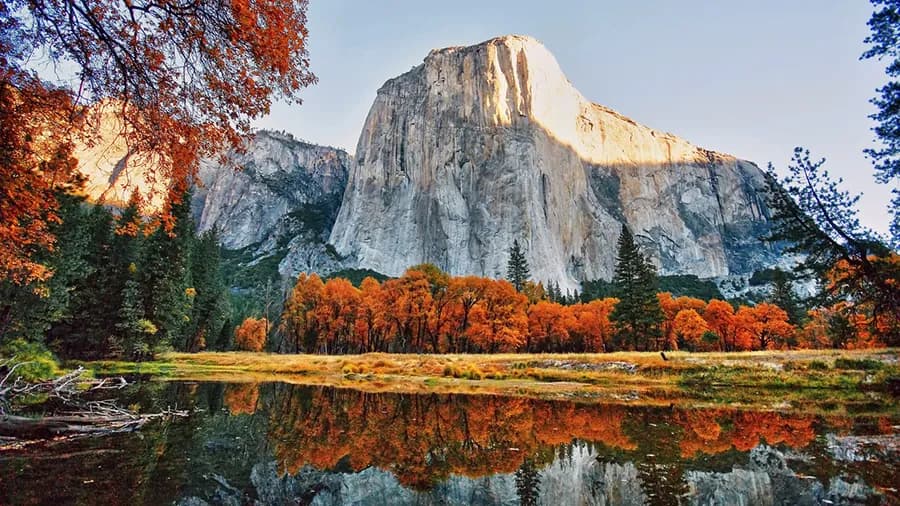Yosemite National Park

Yosemite National Park Overview
Yosemite is one of the most popular national parks in America, known for its stunning views, hiking trails, and family-friendly vacation options. It holds historical significance as the first land in the nation dedicated to recreation and enjoyment, setting the precedent for future national parks.
Located in central California, Yosemite National Park was established in 1890 and attracts around four million visitors annually. Nearly 95 percent of the park’s 747,956 acres, roughly the size of Rhode Island, is designated as wilderness.
The park offers a wide range of activities and scenic spots. Yosemite Valley features a 7-mile wide canyon with impressive rock formations, including El Capitan, the tallest granite monolith in the world and a top rock climbing destination. Yosemite Falls is the largest waterfall in North America, offering breathtaking views especially during peak visitation in spring when it is fed by melting snow. The park is also famous for its Giant Sequoia trees, some of which are believed to be over 3,000 years old.

Things to Do in Yosemite National Park
Yosemite National Park offers a vast array of activities and experiences for visitors of all interests and abilities. Whether you’re seeking a leisurely stroll through scenic meadows or an adrenaline-pumping climb up towering cliffs, Yosemite has something to captivate every adventurer.
Camping
Yosemite National Park is a premier destination for camping enthusiasts, with a variety of campgrounds scattered throughout the park, each offering unique experiences and amenities. From the serene and secluded Yosemite Wilderness to the more developed Yosemite Valley campgrounds, visitors can choose from a range of options to suit their needs and preferences.

Hiking
Yosemite National Park is a hiker’s paradise, with over 800 miles of trails that wind through the park’s diverse landscapes. From short, easy walks to challenging, multi-day excursions, there are hiking options to suit every skill level and interest. Some of the park’s most popular hiking destinations include:
- Yosemite Valley
- Glacier Point Road
- Wawona and Mariposa Grove of Giant Sequoias
- Hetch Hetchy
- Crane Flat and White Wolf
- Tuolumne Meadows

Tours
Yosemite Hospitality offers bus tours throughout the year, all starting in Yosemite Valley.
- The Valley Floor Tour is a two-hour tour of Yosemite Valley that runs all year. From April to October, it’s an open-air tram tour (weather permitting). From October to March, it’s a bus tour.
- The Glacier Point Tour is a four-hour roundtrip tour to Glacier Point and back. One-way tickets are an option. This tour operates when the Glacier Point Road is open, usually from late May to sometime in November, depending on conditions.
- The Grand Tour is a full-day, 8-hour tour that covers Yosemite Valley, Glacier Point, and the Mariposa Grove of Giant Sequoias. This tour runs from late spring to summer, typically from May to September, depending on conditions.
- The Tuolumne Meadows Hikers Bus is an all-day tour to Tuolumne Meadows and back. One-way tickets are available. This tour operates from July to early September, depending on the conditions.

Ranger and Interpretive Programs
Yosemite National Park’s team of skilled rangers and interpreters offer a wealth of educational and immersive programs that bring the park’s history, ecology, and cultural significance to life. From guided hikes and campfire talks to Junior Ranger activities and evening programs, these experiences provide valuable insights and a deeper connection to the park.

Biking
In Yosemite Valley, there are more than 12 miles of paved bike paths with a speed limit of 15 mph. Bicyclists can also ride on regular roads if they follow traffic laws. You have the option to rent a bike, bring your own, or borrow one through the bike share program with a two-hour limit.
When biking on Yosemite’s roads, you will be sharing them with various vehicles, so caution is advised. Children under 18 years old are required by law to wear helmets. Ebikes with two or three wheels, functioning pedals, and electric motors under 750 watts (1 horsepower) are allowed wherever bicycles are permitted, with a speed limit of 15 mph on bike paths.
Electric scooters are permitted on bike paths but not on park roads, with the same speed limit of 15 mph. Off-trail riding, mountain biking, and using motorized scooters on bike paths are not allowed in Yosemite National Park.
You can rent bicycles at Curry Village, Yosemite Village, and Yosemite Valley Lodge in Yosemite Valley. Additionally, electric scooters, wheelchairs, strollers, helmets, and tagalong bikes are available for rent. All rental bikes are on a first-come, first-served basis, except for ADA bicycles, hand-crank bicycles, and tandem bicycles for visually impaired guests which require reservations.

Rock Climbing
Yosemite National Park is renowned for its world-className rock climbing opportunities, attracting skilled climbers from around the globe. From the iconic granite walls of El Capitan and Half Dome to the countless other challenging routes, Yosemite offers a climbing experience like no other.
A wilderness climbing permit is mandatory for all climbers who plan to spend the night on big wall climbs in Yosemite.

Volunteering
Yosemite National Park has a thriving volunteer program that attracts individuals from various countries. Volunteers can take on roles such as providing visitor information, studying rare birds of prey, cleaning up litter, and constructing trails. In 2018, the park had more than 13,000 volunteers who collectively contributed over 128,000 hours of service. This is valued at approximately $32 million in unpaid labor. Without the dedication of volunteers, essential tasks in Yosemite would go unfinished.

Water Activities
Yosemite National Park is home to a network of rivers, lakes, and waterfalls that provide endless opportunities for water-based activities. From peaceful paddling to thrilling whitewater adventures, visitors can immerse themselves in the park’s aquatic wonders.
- Rafting: Guided and self-guided rafting trips on the Merced and Tuolumne Rivers, offering varying levels of difficulty.
- Kayaking and Canoeing: Peaceful paddling experiences on the park’s tranquil lakes and reservoirs.
- Swimming: Refreshing dips in the park’s many swimming holes, waterfalls, and lakes. x
Winter Sports
Cross-country skiing and snowshoeing in Yosemite offer a sustainable and enjoyable way to explore the vast landscape, with snow protecting delicate plants from damage caused by human activity.
Winter routes in Yosemite typically have sufficient snow cover from mid to late December through mid-March, although conditions may vary each year.
Navigating winter trails can be challenging as trail signs are often hidden under snow. Metal signs and markers attached to trees may be obscured or knocked down by snow, and following existing ski or snowshoe tracks does not guarantee you will reach your desired destination.

Places to Stay in Yosemite National Park
Yosemite National Park offers a variety of accommodation options, catering to a range of budgets and preferences. From rustic campgrounds to luxurious resorts.
Camping
Reservations are necessary for all campgrounds from around April to October. During late fall, winter, and early spring, there are three campgrounds that operate on a first-come, first-served basis. These sites tend to fill up quickly, particularly on weekends and holidays. However, from late May to October, first-come, first-served camping is not an option.

Hotel and Resort
For those seeking a more comfortable and amenity-rich stay, Yosemite National Park offers a selection of hotels, lodges, and resorts, each with its own unique charm and character.
Yosemite Valley Lodge is a popular option for families and big groups due to its convenient location near Yosemite Falls. It serves as an ideal starting point for exploring Yosemite National Park. The lodge’s design, featuring glass and wood elements, blends well with the natural surroundings. Its numerous windows let in plenty of sunlight and offer stunning views of the mountains.
- Address: 9006 Yosemite Lodge Dr, Yosemite National Park, CA 95389
- Price Range: From $400/night depending on the season and demand

The Ahwahnee stands out as the luxurious hotel in Yosemite National Park, renowned for its stunning exterior and design. It was carefully crafted to complement the beauty of its surroundings, showcasing iconic landmarks like Yosemite Falls, Half Dome, and Glacier Point.
- Address: 9005 Ahwahnee Drive, Yosemite National Park, CA 95389
- Price Range: From $713/night depending on the season and demand

Curry Village, previously known as Half Dome Village, offers various types of accommodations such as Hotel Rooms, Cabins with Private Bathrooms, Cabins without Private Bathrooms, Heated Tents, and Unheated Tents. Curry Village operates seasonally and has 5 Food and Beverage Outlets during the busiest times.
- Address: 9010 Curry Village Drive, Yosemite National Park, CA 95389-9907
- Price Range: From $250/night depending on the season and demand

Dining
Yosemite National Park boasts a diverse culinary scene, with a variety of dining options to satisfy every palate. From casual cafes and food trucks to upscale restaurants, visitors can enjoy local and sustainable cuisine while immersed in the park’s natural beauty.
Situated in Yosemite Valley Lodge, the Mountain Room restaurant offers stunning views of the 2,424-foot Yosemite Falls. The menu is impressive, with a variety of options, such as delicious steaks, fresh seafood, and flavorful pastas. The chef’s specialties focus on using local, organic ingredients that are in season, including sustainable fish and seafood recommended by the Monterey Bay Aquarium Seafood Watch List.
- Address: 9006 Yosemite Lodge Dr Yosemite Valley Lodge, Yosemite National Park, CA 95389
- Open time: 5:00 PM – 9:00 PM
- Prices range: $15 – $52

The Wawona Hotel Dining Room offers a genuine Victorian-era atmosphere with hand-painted lamps and a lovely veranda for dining in the summer. You can enjoy excellent cuisine every night. You can cozy up by the fireplace, unwind on the lawn in comfortable Adirondack chairs, or savor a delicious meal in the main dining room.
- Address: 8308 Wawona Rd, Yosemite National Park, CA 95389
Open time:
- 7:00 AM – 10:00 AM
- 11:00 AM – 3:00 PM
- 5:00 PM – 9:00 PM
- Prices range: $30 – $50

After a thrilling day outside, the bar is an ideal spot to relax. It provides a calming ambiance and outdoor seating that overlooks the stunning Yosemite National Park. The Ahwahnee Bar is a comfortable place to savor a drink, a snack or a small meal.
- Address: 1 Ahwahnee Road, Yosemite National Park, CA 95389
- Open time: 2:00 PM – 9:00 PM

Planning Your Trip to Yosemite National Park
Visiting Yosemite National Park requires careful planning and preparation to ensure a seamless and enjoyable experience.
Visiting Time
Yosemite National Park is a year-round destination, with each season offering its own unique charm and opportunities. The most popular times to visit are during the summer months, when the weather is warm and the park’s iconic waterfalls are in full flow. However, the park’s shoulder seasons, such as spring and fall, can also be an excellent time to explore, with fewer crowds and more moderate temperatures.




Transportation
Driving to the park and exploring by car is a popular and convenient option, allowing for maximum flexibility and the ability to reach more remote areas.
In addition, Yosemite offers shuttle services and public transportation options, which can be a hassle-free and environmentally friendly way to navigate the park. Joining a guided tour, either by bus or private vehicle, can provide a seamless and informative way to experience the park’s highlights.

Conclusion
Yosemite National Park is a natural wonder that captivates the soul and leaves an indelible mark on all who venture within its boundaries. This UNESCO World Heritage Site is a testament to the power and beauty of the natural world.
As you plan your journey to Yosemite, remember to embrace the park’s rich cultural history, connect with the land, and leave no trace, so that future generations can continue to marvel at this natural wonder. Yosemite National Park is truly a timeless destination, a place where the grand scale of nature is on full display and the beauty of the world is revealed in all its glory.


